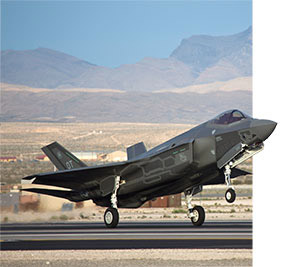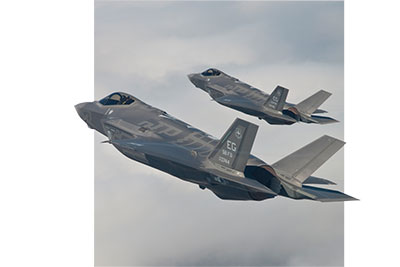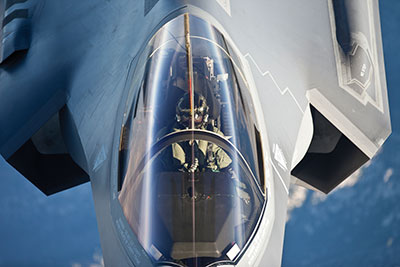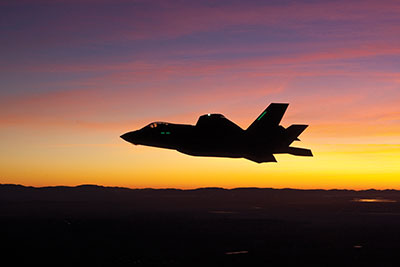
Features
The F-35 Lightning II up close and personal
Canada has embarked on a venture to update the fighter jet capability of its air force, most notably marked by a surprise announcement during the summer doldrums in July 2010 that the government had committed to purchase 65 aircraft at a program cost of just over $17 billion.
November 14, 2013 By Walter Heneghan
Canada has embarked on a venture to update the fighter jet capability of its air force, most notably marked by a surprise announcement during the summer doldrums in July 2010 that the government had committed to purchase 65 aircraft at a program cost of just over $17 billion.
 |
|
| The stealth coating of the composite aircraft skins on the wings and fuselage is maintained through a continuous monitoring program using software designed by Vancouver-based NGRAIN. Photo: Lockheed Martin
|
Since that announcement, the program has been mired in controversy. The parliamentary budget officer has suggested that the cost would be in excess of $29 billion, and more recently, the auditor general has reported this figure to be closer to $45 billion.
In response to the controversy in how this purchase has been costed, Lockheed Martin has embarked on an aggressive program of educating the public through a Canada-wide tour of its “mini” simulator together with a presence in military trade shows and enhanced media availability. Earlier this year, Wings magazine was invited to visit the production facility in Fort Worth, Tex., and the training centre in Fort Walton Beach at Eglin Air Force Base (AFB).
The reigning queen of the Royal Canadian Air Force (RCAF), the CF-18 Hornet, was introduced into service in 1982, with Canada purchasing 138 aircraft at an initial cost of $4 billion dollars, or $8.9 billion in 2011 dollars. The 20-year life cycle cost for the aircraft, including fleet upgrades and maintenance costs, has been reported to be $16.5 billion. The programmed F-35 acquisition calls for half that number of aircraft (65 fighters), with an initial acquisition cost projected to be $6 billion and life cycle costs between $29 and $45 billion dollars.
Lockheed Martin purports the per-unit cost to be closer to $85 million per aircraft, or $5.53 billion. Either way you cut up this pie, it will be a major acquisition that will mark a generational change for the RCAF. But what will we get for this money?
Dave Scott, the director of international business development for the F-35, is an enthusiastic supporter of the signature element of this aircraft – stealth. “Stealth is designed into the airframe at multiple levels,” notes Scott. This is echoed by Keith Knotts. “Stealth is designed into the aircraft based on future threats and the requirement for the F-35 to have that level of stealth capability at the end of its life. It is not a Day 1 requirement, it is an end-of-life capability.”
The stealth nature of the aircraft is a major theme with both gentlemen stressing the design features that enhance the F-35’s “stealthiness.” Building on the successes of both the F-177 Stealth Bomber and the F-22 Stealth Fighter, Lockheed Martin has retained that signature angular design that minimizes radar reflection. They use also a set-back engine intake design (you cannot see the front of the engine) that more effectively deflects radar energy, referred to by their test pilots as the “duck’s back.”
 |
|
| The F-35 builds on the successes of both the F-177 Stealth Bomber and the F-22 Stealth Fighter. Lockheed Martin retained the same angular design that minimizes radar reflection. Photo: Lockheed Martin
|
Lockheed Martin is proud of the engineering effort built into the aircraft in regards to the potential for reflecting radar energy, and has attempted to eliminate that risk through design. Furthermore, the leading edge of the wing aligns with the tail, which matches the fuselage so that the radar profile is minimized. The aircraft finish is “exceptionally smooth” with the outer surfaces machine mated complete with integrated flush-mounted antennae. The stealth coating of the composite aircraft skins on the wings and fuselage is maintained through a continuous monitoring program using software designed by Vancouver-based NGRAIN so that the stealth efficiency of the airframe can be maximized.
The stealth nature of the Lightning II doesn’t end here. The aircraft can carry 18,000 pounds of fuel and four anti-aircraft missiles at a top speed of Mach 1.6 up to 50,000 feet above sea level with no external ordnance or fuel tanks. Keeping a clean configuration in a high performance mode is key to the aircraft’s stealth profile. Lockheed is quick to boast that this capability far exceeds anything the CF-18 can offer.
The F-35 is more than just a stealth platform. This fifth-generation fighter technology has been designed to counter weapons systems that are just now coming on line, surface-to-air and ship-borne systems. It comes equipped with three external hard points that will allow a less stealthy profile if there is a need to add the two 600-gallon external fuel pods, or up to 18,000 pounds of additional armament. So, if the mission calls for more firepower and less stealth, 12 AMRM and two AIM 9 missiles can be added to bolster the aircraft’s capabilities.
Electronically it is a beast, boasting a fifth-generation sensor system that can be used for border security and arctic surveillance, providing “horizon to horizon” coverage. A key feature of the surveillance capability is an advanced, active, electronically scanned array that uses a lower energy profile than traditional radar systems. The Distributed Aperture System, or DAS, features two cameras, which together with six unique sensors create a global 360-degree image for the pilot to access. This will be the first
fighter that gives a pilot “eyes in the back of his head” or underneath the aircraft.
Knotts proudly stated that, “the F-35 has 10 times the dedicated jamming power of the F-18 Growler variant.” The complement to the DAS is the EOTS – Electronic Optical Targeting System – that is located under the chin of the jet. It is comparable in technology to a “sniper pod “but is integral to the aircraft and comes as “standard equipment.” All this data and information is melded through the Multifunction Advanced Data Link (MADL) that connects all the aircraft in a sortie with one another. This system uses a very high speed, low probability of intercept, encrypted datalink.
Overall, the F-35 Lightning II is designed to be a data-collecting behemoth, able to communicate and share information with its sister aircraft and offering the potential to virtually create a complete 3D data picture over 200 nautical miles, with each jet sharing and computing surveillance and targeting solutions from horizon to horizon. From this perspective, the aircraft appears to be groundbreaking. Today’s aircraft fly within visual contact of one another; a flight of F-35s could potentially be miles apart yet still provide reams of data to one another to assist all pilots in the sortie with their battle and situational awareness. Yet, with this new technology, the F-35 can still tie into over 100 other legacy communications and data systems, both airborne and ground-based arrays. The data and communications capabilities of the aircraft are integral to the weapons systems, negating the requirement for additional expenditure to acquire these tools.
The project is extensive. The United States started as the cornerstone client, as it often is for projects of this scope, when the program began in 2001. The United Kingdom, Italy, the Netherlands, Canada, Turkey, Australia, Denmark and Norway are the other enterprise partners, coming on board in 2002. Israel and Japan joined the development program in 2006. These 11 countries have made commitments in one form or another for more than 3,800 aircraft through the life of the production cycle.
The aircraft is anticipated to be in production for 30 years with a 30-year, in-service life cycle. It has a budgeted $60-billion development cycle, with a goal to produce an aircraft that is agile, forward deployable, stealthy and capable of delivering lethality to the battlefield.
The design life of each airframe is currently 8,000 hours with a requirement for depot level maintenance and overhaul every 2,000 hours. Scott emphasized the point that this maintenance will be a national capability. “The intention is that the airplane will never have to leave the country in which it is operated to conduct any maintenance required,” he said. As is typical with complex weapons systems of this type, development, testing and certification is taking place concurrent with production.
 |
|
| The design life of each F-35 airframe is currently 8,000 hours with a requirement for depot level maintenance and overhaul every 2,000 hours. Photo: Lockheed Martin
|
The U.S. government appears to be fully behind this acquisition, as the development program has been fully funded in fiscal years (FY) 2013 and 2014, in spite of sequestration and the legislative logjams in Congress. Both the U.S. secretary of defence and the U.K. minister of defence are on the record as being fully committed to the F-35 program. In the U.S., the marines will be the first command to take delivery, train and be fully operational with a squadron of F-35 fighters, tentatively planned for Q3 2015.
Pilot induction and training, both in full-motion flight simulators and with actual aircraft, is underway at Eglin AFB in Florida. This activity is concurrent to the test and development work that is happening in Fort Worth at the Lockheed Martin facility, Edwards and Nellis AFBs, the Patuxent River Naval Air Station, and the USMC Yuma Proving Ground.
Lockheed is fortunate in having extensive experience with stealth technology from the development of the F-117 and F-22 aircraft, and the F-35 program has benefited from the in-house engineering data. “As of mid-Q2 of this year (2013), 235 aircraft have been delivered or are on order,” according to Scott. “Over 4,500 sorties amassing 6,000 fleet hours shows the underlying maturity of the program, even at this early stage. By way of comparison,” he was quick to add, “the F-22 program only delivered 127 aircraft in total.” Scott is very proud of the progress of the F-35. To date, no aircraft have been lost.
Production of the aircraft is fully funded through five years of production with the first international deliveries expected to occur in 2014. While the production rate is currently reflective of the development phase of the aircraft, end state production capability will be in excess of 200 aircraft per year.
Lockheed Martin is keen to point out the economic spinoffs to Canada from the F-35 development and production program. The IRB, or Industrial Benefits, side of the equation is not to be discounted. Scott pointed out that, “$450 million worth of contracts have been let to Canadian suppliers, with an estimated $10 billion in industrial benefits over the life of the program.” He stated that Canada, as a development partner, was “well positioned” for these economic payoffs. He didn’t hesitate to add, however, that, “these partnership benefits are not unconditional. They are proportionate to the commitment of the partner nations and will be concurrent with their deliveries.”
The obvious message: sign up for F-35s or miss out on the industrial benefits of the program. When pressed, he offered that the “$450 million is under contract” and that the $10 billion would just be an extension of those contracts throughout the production cycle. As a point of interest, the make/buy ratio is in the order of 25 per cent to 75 per cent, in that 75 per cent of the payoff economically occurs throughout the supply chain with the remainder accruing to Lockheed Martin itself.
Scott was keen to add that the total IRB was up from the initial estimate of $2 billion when the Canadian government signed the Memoradum of Understanding in 2006. One spin off from the Canadian industrial involvement is the transfer of technology and the subsequent development of a specialized, skilled workforce that is “inside” the military industrial complex. Notes Scott, “The technology transfer increases the capability and status of Canadian industry, not just for future work within Lockheed Martin, but potentially for other programs such as Pratt & Whitney.”
There is no doubt that the F-35 will be a fine fighter aircraft. It has incorporated many features from the most recent innovations featured in the F-117 and F-22 programs but its big claim to fame is what Lockheed Martin is most proud of – stealth.
From Flynn’s perspective
Lockheed Martin provided an experienced test pilot and engineer to our group during the tour of the Fort Worth facility who proved to be a knowledgeable and experienced advocate of the F-35: Lt.-Col. (retired) Billie Flynn.
Flynn was a career fighter pilot in the Royal Canadian Air Force and Lockheed was keen to have a credible advocate to address Canadian concerns, from a Canadian perspective. Lt.-Col. Flynn joined Lockheed Martin in 2003 after a stint with the Eurofighter 2000 typhoon project and sports strong test pilot and aircraft development credentials.
 |
|
| The F-35 can carry 18,000 pounds of fuel and four anti-aircraft missiles at a top speed of Mach 1.6 up to 50,000 feet above sea level. Photo: Lockheed Martin |
More important than that to Lockheed Martin, Flynn is a poster boy fighter jock F-35 booster. Cut from the same cloth as Val Kilmer’s “Iceman” in the hit movie, Top Gun, Flynn walks, acts and talks the part. Fit and trim in his flight suit, he quickly filled in the blanks from the initial presentation. With more than 5,000 hours in more than 70 aircraft types, Flynn knows the file. He gets right to the point: “Fourth gen (generation) aircraft [F-16, F-18, etc.], it’s about kinematics, how fast you go, how much G you pull, but when I look at the F-35, when I look at the capability of a fifth gen aircraft, and I look at the roles it has to do in Canada, it is the easiest conversation. This is an airplane that will do anything that Canada expects.” Point, set, match, next question. “Everything about this jet is about stealth, it is the third major aircraft build with stealth [F-117, F-22 and now F-35].”
“Lockheed Martin has learned from that experience, morphed that experience into the F-35,” added Flynn. “Stealth matters – from nuts and bolts to panels and ordnance.” The Iceman Cometh. Flynn then makes the argument about stealth in the Arctic, stating that stealth for sovereignty operations is a necessary tool. This author isn’t convinced. Sovereignty is about showing the flag, not hiding behind it.
Flynn waxes eloquent about the G suit improvements, the sensor systems, the pilot’s flight helmet. Everything is precise. Everything is on point. I would have been interested in observing Flynn debate the program’s “Maverick” – the other perspective. It would have been a treat.